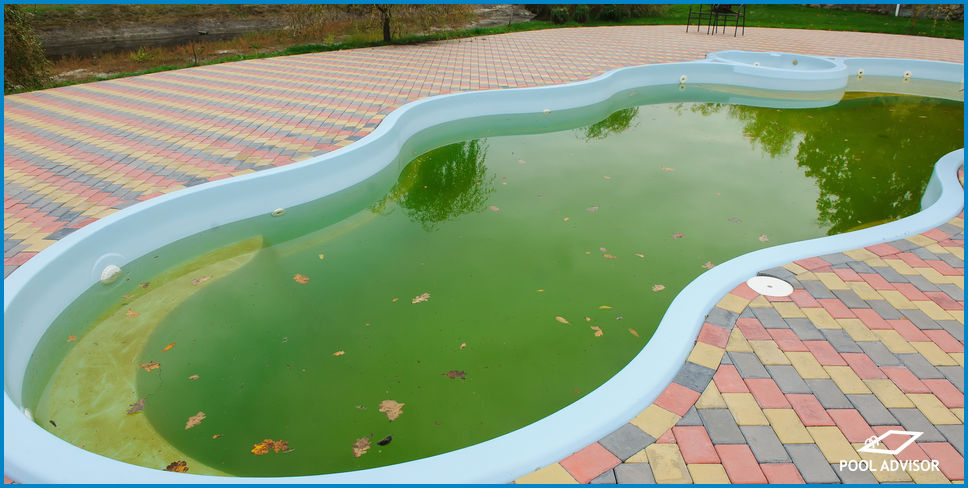
Pool Green After Rain - Why? How To Fix It?
While cloudy pool water after a rainstorm is a fairly common occurrence, rain that causes your pool to rapidly turn green is more rare and can be startling to see. Luckily, pool water that has turned green from rain can be returned to its former clarity by following some simple steps.
In this article we will talk about the reasons why rain can turn your pool water green, what steps you can follow to make your water clean again, and ways that you can potentially prevent green water from occuring in the future.
Why Does Rain Cause Green Pool Water?
When rain causes your pool water to turn green, it is usually due to the water becoming diluted. As fresh rainwater enters your pool, the chemistry of your water is significantly altered.
You will experience a drop in chlorine and may also notice changes in the total alkalinity levels of your pool which can also present as abnormally high or low pH.
In addition to changing the chemical balance of your pool water, rain can also introduce pollutants into your pool. These pollutants can be collected dust particles from the air, or may enter your pool in the form of ground runoff.
Organic pollutants that enter your pool during rain often act as a source of nutrients for unwanted microorganisms in your water such as bacteria and algae.
As bacteria and algae begin to develop in your water, chlorine levels may drop even further, beginning to create an unsanitary environment that is unsafe for swimmers.
Once these microorganisms begin to rapidly reproduce, you begin to notice a change in water colour due to the increasing number of particles.
Note: Diluted chlorine levels are not the only cause of a green pool. If you have tested your pool after the rainstorm and found high chlorine levels, check out this guide on dealing with a green pool with high chlorine.
How to Fix Green Pool Water After Rain
Shock The Pool
The first step that we recommend taking to correct pool water that has turned green after rain is to use a shock treatment.
Shock treatments typically contain high amounts of chlorine which can help to restore your diluted chlorine levels, but there are also chlorine-free options available that better suit other types of pools.
Use this pool shock calculator to work out an appropriate dose of chlorine for shocking your pool.
Balance Water Chemistry
Balancing your pool’s chemistry is the next essential step you must take to clear up any green water. The shock treatment you used likely had instructions for adjusting your water chemistry prior to its use.
After the shock treatment product is no longer active in your pool in high amounts, you will want to return all chemistry levels to normal.
We recommend testing and adjusting your levels for chlorine, pH, and total alkalinity. Most 4-in-1 test kits have testing solutions for all three of these properties and more.
Ideal levels of chlorine should be between 2-4 parts per million (ppm), with a total alkalinity between 80-120ppm, while pH levels should remain neutral at 7.2-7.6.
Most of the time. your alkalinity will be low after a rainstorm, so you may need to increase it.
Add Phosphate Remover (Optional)
If your pool does not become noticeably more clear after taking these first steps and allowing your filter to run several hours, you may have a more prolific algae infestation.
In the case that green is still present in your pool at this point, you will want to test your phosphate levels. Phosphates are a benign, natural substance that slowly builds up in your pool’s water through regular use and can be introduced more rapidly with other debris.
Phosphates act as a food source for algae, so even in adequately chlorinated conditions, algae can sometimes thrive if you have high phosphates.
You can test your phosphates with a specialised kit, which uses test stips for easy results. Pools with phosphate readings higher than 300 parts per billion (ppb) can have an increased risk of algae developing, and this effect is drastically increased at levels greater than 500ppb.
In order to remove high phosphates, you will need a product designed especially for this purpose. We recommend Lo-Chlor Starver M, which is easy to use and is strong enough to suit most at-home pool owner’s needs.
Bear in mind that these phosphate removers are general coagulants, and can therefore make your pool cloudy. Keep an eye on this and make sure you run your filter for an appropriate amount of time after dosing.
Add Algaecide (Optional)
After removing phosphates, you may also opt to use an algaecide to kick any remaining traces of algae to the curb for good. We like the Lo-Chlor Pool Algaecide for its long-lasting effectiveness; one treatment of this product will keep algae from returning for a full 90 days.
Preventing Green Pool Water After Rain
If you regularly receive large amounts of rain that are capable of diluting your pool water, you may want to invest in a pool cover that can be used to keep rainwater out. Rainwater will collect on top of this tarp instead of in your pool, and should be syphoned off before your pool is reopened.
If you simply do not have the time available to cover and uncover your pool for each rain, you can also be proactive about your water’s chemistry by testing your chemicals as soon as possible after a storm has passed.
In the event that a storm lasts longer than a day, you may want to test your chlorine levels during the rainfall and add an emergency dose to prevent levels from dropping too low.
For your safety, remember to never go near your pool during a storm that is producing any thunder, lightning, or hazardously strong winds.
If you are looking for a preventative product for keeping your water clear during rain, our favourite option is the Crystal Cube Plus Blocks.
These cubes are placed in your skimmer basket and work to remove phosphates and small particles of debris from your water that can otherwise be too tiny to be picked up by your filter.
Conclusion
Green pool water after rain can be shocking to see, as it can develop so quickly in an otherwise clean pool. Thankfully, there are simple steps you can take to restore your water clarity after this occurs.
Green pool water caused by rain can also be prevented in many cases by keeping an eye on your water chemistry.
It is essential that pool owners stay on top of the precise changes in their pool’s chemistry by using a test kit in order to prevent unsightly water and potentially unsafe swimming conditions.
Do you have any remaining questions about pool water turning green after a rain? Let us know in the comment section!

Louis
A chemical engineer by trade, Louis is committed to debunking myths in the pool industry by explaining the underlying chemistry and making it accessible to all.
